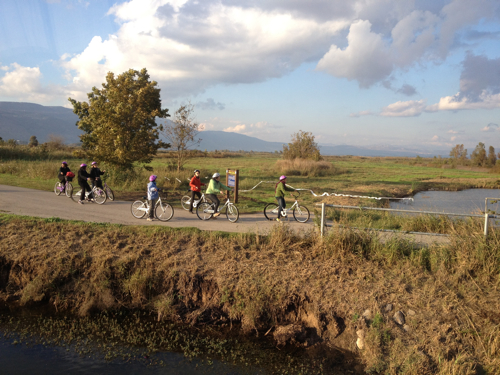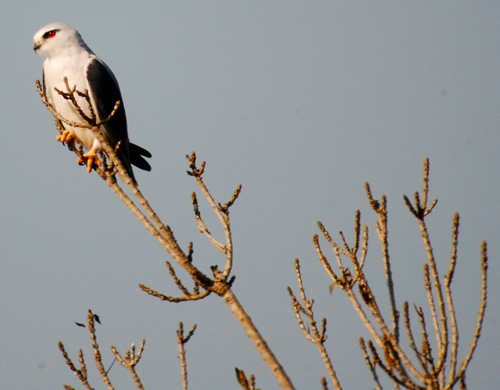 I've blogged already that the Agamon Hula is fabulous for common crane watching but that barely scratches the surface of all the bird life that can be found at this birding hotspot. The refuge has a little over 5 miles of trails that can only be accessed on foot, bike or electric golf cart. I love a place where one can safely and easily ride bikes for birding (biking is awesome, even if you dip on a bird, you still win by getting exercise). The trails are well maintained and it's relatively flat so even if you don't consider yourself a hardcore bike rider, you should be able to do it.
I've blogged already that the Agamon Hula is fabulous for common crane watching but that barely scratches the surface of all the bird life that can be found at this birding hotspot. The refuge has a little over 5 miles of trails that can only be accessed on foot, bike or electric golf cart. I love a place where one can safely and easily ride bikes for birding (biking is awesome, even if you dip on a bird, you still win by getting exercise). The trails are well maintained and it's relatively flat so even if you don't consider yourself a hardcore bike rider, you should be able to do it.

And there are a variety of bikes to use and rent out from the refuge (as well as the electric carts visible above). If you want to take out some scopes or cameras, these are perfect. I especially like the three seater bike above. Your optics can go in the middle seat and with two people you can share the pedaling. There's also space in the back of the above for more people to ride or to store a cooler with beverages and snacks. The birds are accustomed to the bike and cart traffic so don't worry about flushing birds when you pedal up. I did have a big giggle moment while we were at the Hula. As I traveled with our posse (all men and me the only female) some teenage women biked past our group they were all dressed very modestly but did indeed bat their eyes at the male birders--where else will male birders get hardcore flirting from young women?

The trails weave around the wetlands that in November are chock full of waterfowl. You'll also find snipe and even a crake or two if you are really observant.

I never cease to be amazed by seeing birds I would see in the US--like the above coots alongside a spur-winged lapwing (say the name of that bird five times fast). There were also mallards, gadwall and green-winged teal.

Or I see odd variations of common birds at home. Above is a pygmy cormorant. It looks like the cormorants we have here in the US but is about the size of a duck--a surprisingly cute cormorant...though I doubt very cuddly.

This handsome fellow is a male Eurasian wigeon (a cinnamon colored counter part of our American wigeon). Whether you are on foot or on a bike or cart, it's fairly easy to get great views of the birds.

And it's not just waterfowl, there are tons of songbirds like the above white-spectacled bulbul--which I was delighted to learn that bulbul is Hebrew for penis. Brings a whole new meaning to announcing, "There's a bulbul in my bush!" I don't quite see why you would name a bird of that body part, not sure I see the resemblance...

If you are nervous about visiting the refuge and missing information, there are podcasts and cell phone tours. Just watch for the Sassy Looking Cell Phone Gal for your clue to get info--audio tours are offered in Hebrew, Arabic and English.

For people who enjoy bird banding and ringing the Agamon has an active banding program. I had to smile, they were very excited to have this rare bird at the banding station when I arrived. Recognize it? It's a house sparrow. North Americans appear to have an over abundance, but in their native lands house sparrows are on the decline!

Other birds they showed us up close included a pair of penduline tits (I saw these in Kazakhstan a few years ago and even got a picture of a penduline tit nest). It was fun to see birds again that I thought I might never have the opportunity to chase again.

Here's a reed bunting...if you love brown birds this is the place to be!

Birds aren't the only highlight of the Hula Valley, mammals abound too. Above was a friendly neighborhood nutria getting the full paparazzi treatment. Some of you may be saying to yourself, "Hey, wait a minute there, Birdchick. Nutria or coypu as they are also known aren't native to Israel. They're from South America, what gives?"
They were introduced to be a booming fur trade. Alas, after the nutria were released people suddenly realized that Israel doesn't get cold winters and the critters never grow that luscious winter fur and they remain unharvested. Big score for the anti-fur movement, not so much for conservation. Not many of the predators in the area eat the introduced nutria so their numbers swell.

Speaking of predators, we saw quite a few of the above jungle cats. Our guide Jonathan Meyrev assured us that the numbers we were seeing was an unusual phenomena. They kind of look like giant house cats with stubby tails. But they stalk the cranes and other waterfowl in the area. Another mammal that I was really excited to see but couldn't get a photo of was a jackal! You get a little of everything in the Hula.

Agamon is also just lousy with eagles. Above is a great spotted eagle and these birds cruise around watching for cranes that died in the night and chow down on the remains. Black kites and pallid harriers frequently cruise the refuge too but several species of raptor can be found.

The Agamon Hula was incredibly proud of this black-shouldered kite, a pair nested there for the first time in 2011. The young had recently left the nest when we visited in November but we still got to see the adults (that's one above) hunting with the young.

Depending on when you visit will determine the types of species you will see. For example we saw a few storks but not the huge numbers the refuge has in other months--there's something different every time you visit. This is a great area to get some European species, African species as well as Middle Eastern birds. A perfect confluence that gives you a variety of species and also the spectacle of tens of thousands of birds passing through during spring and fall migration. Whether you visit Agamon Hula in November like I did or any other time of year, you will not be disappointed. I've been to a lot of places and I would put this on my list of must visit areas for any bird watcher around the world.
